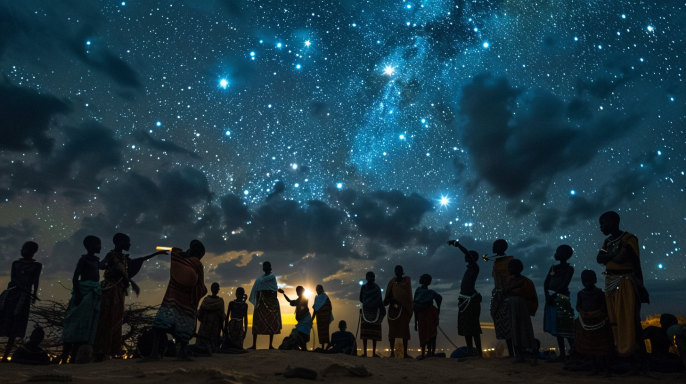Introduction
The Dogon tribe of Mali, West Africa, is renowned for its advanced astronomical knowledge, particularly regarding the Sirius star system. Their understanding of Sirius B, a star invisible to the naked eye, has long puzzled researchers and sparked numerous theories about extraterrestrial contact.
Origins and History of the Dogon Tribe
The Dogon people have a rich history that dates back over a thousand years. Originally migrating from areas further north, they settled in the cliffs of Bandiagara in Mali. Their society developed complex cultural practices and a deep understanding of the cosmos, which are reflected in their myths and rituals.
The Dogon Cosmology
Dogon cosmology is deeply intertwined with their spiritual beliefs. They hold a unique connection to the Sirius star system, with intricate myths detailing the origins of their knowledge. Their cosmology includes a rich pantheon of deities and spirits, with the Nommos, amphibious beings from Sirius, playing a central role.
The Sirius Mystery
The Dogon’s knowledge of Sirius A and Sirius B is particularly astonishing. They describe Sirius B as a small but immensely heavy star, which aligns with modern astronomical findings about this white dwarf. The Dogon claim this knowledge was passed down by the Nommos, who visited Earth in ancient times.
Sirius B: The Invisible Star
Sirius B, part of the Sirius star system, is not visible to the naked eye. It was only discovered by Western astronomers in the 19th century, yet the Dogon had detailed knowledge of its characteristics centuries earlier. Their descriptions match the scientific understanding of Sirius B’s size, density, and orbit.
The Nommos: Alien Visitors?
Dogon legends speak of the Nommos, aquatic beings from Sirius who descended to Earth in a spacecraft. These beings are said to have imparted advanced knowledge to the Dogon, including details about Sirius B. This legend has led to speculation about ancient extraterrestrial contact.
Rituals and Ceremonies
The Dogon perform various rituals and ceremonies that align with astronomical events. These include the Sigui festival, which occurs every 60 years and is linked to the orbit of Sirius B. Their rituals are intricate and filled with symbolic meanings tied to their cosmological beliefs.
Dogon Astronomy and Modern Science
Modern science acknowledges the accuracy of the Dogon’s astronomical knowledge, but the source of this knowledge remains a topic of debate. Some scholars argue that the Dogon could have obtained this information through early contact with Western astronomers, while others believe in the possibility of ancient extraterrestrial influence.
Exploration by Western Researchers
French anthropologist Marcel Griaule is one of the key figures who studied the Dogon in the 1930s. His work brought the Dogon’s astronomical knowledge to the attention of the world. Griaule’s interpretations, however, have been both celebrated and critiqued, leading to ongoing debates.
Skeptical Perspectives
Skeptics argue that the Dogon’s knowledge could have been influenced by contact with Europeans, possibly through indirect transmission of information. They question the reliability of Griaule’s accounts and suggest alternative explanations for the Dogon’s knowledge of Sirius B.
Cultural Significance
Astronomy plays a vital role in Dogon culture, influencing their art, architecture, and daily life. Their intricate sculptures, masks, and buildings often reflect astronomical themes, showcasing their deep connection to the cosmos.
The Dogon Today
Today, the Dogon face various challenges, including modernization and environmental changes. Despite these pressures, they strive to preserve their traditional knowledge and cultural practices. Efforts are being made to document and protect their heritage.
Anthropological Insights
Understanding the Dogon through their own perspective offers valuable insights into their worldview. Their cosmology and rituals provide a window into a unique way of interpreting the universe, blending spiritual and astronomical knowledge.
Mysteries and Unanswered Questions
Despite extensive research, many mysteries about the Dogon’s knowledge remain unresolved. How they obtained such detailed information about Sirius B is still debated, and the full extent of their astronomical understanding continues to intrigue scholars.
Conclusion
The Dogon tribe’s astronomical knowledge is a testament to the complexity and depth of indigenous knowledge systems. Whether their insights were gained through ancient contact with extraterrestrials or other means, the Dogon’s legacy remains a fascinating chapter in the history of human understanding of the cosmos.
FAQs
How did the Dogon tribe gain their knowledge of Sirius B?
The Dogon attribute their knowledge of Sirius B to the Nommos, mythical beings from the Sirius star system. However, the true source of their knowledge remains a subject of debate among researchers.
Who are the Nommos in Dogon mythology?
The Nommos are amphibious deities in Dogon mythology, believed to have come from the Sirius star system. They are central to Dogon cosmology and are credited with imparting advanced knowledge to the Dogon people.
What rituals do the Dogon perform related to astronomy?
The Dogon perform several rituals linked to astronomical events, including the Sigui festival, which occurs every 60 years and is associated with the orbit of Sirius B. These rituals are rich in symbolism and reflect their deep astronomical knowledge.
How has modern science viewed the Dogon knowledge?
Modern science recognizes the accuracy of the Dogon’s knowledge of the Sirius star system but remains divided on how they obtained this information. Some suggest early contact with Western astronomers, while others explore the possibility of ancient extraterrestrial influence.
What challenges do the Dogon face today?
The Dogon face challenges from modernization, environmental changes, and the need to preserve their cultural heritage. Efforts are being made to document and protect their traditional knowledge and practices for future generations.

